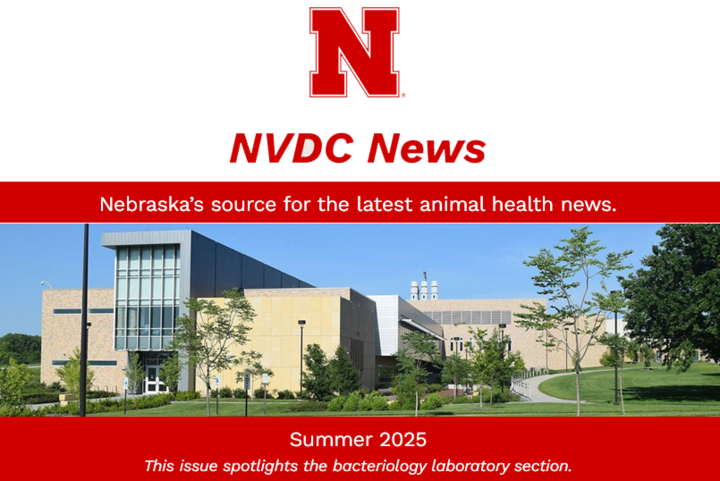
Bacteriology Laboratory Section
By Laura Leger
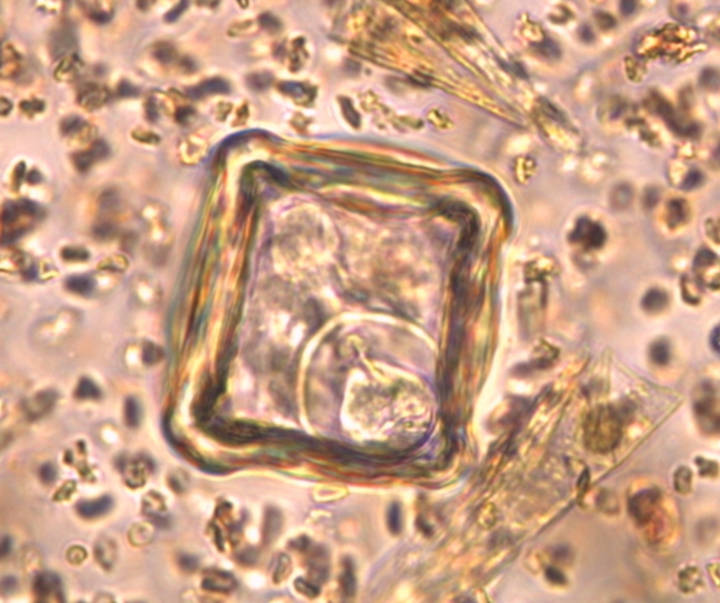
What we do
The bacteriology department analyzes and identifies bacterial, fungal and parasitic organisms in veterinary clinical samples received from across Nebraska and the Midwest.
The bacteriology department performs serological testing for export and non-export animals, susceptibility testing on bacterial pathogens, analysis of bacterial pathogens utilizing MALDI-TOF mass spectrometry technology, and poultry testing in compliance with the National Poultry Improvement Plan (NPIP).

Summary of testing
The bacteriology lab:
- Processes over 15,000 bacterial cultures per year, screening for various pathogens from a variety of animal species.
- Processes over 11,000 cultures per year for poultry facilities across Nebraska.
Tests over 1,000 bacterial pathogens per year using antimicrobial susceptibility testing.
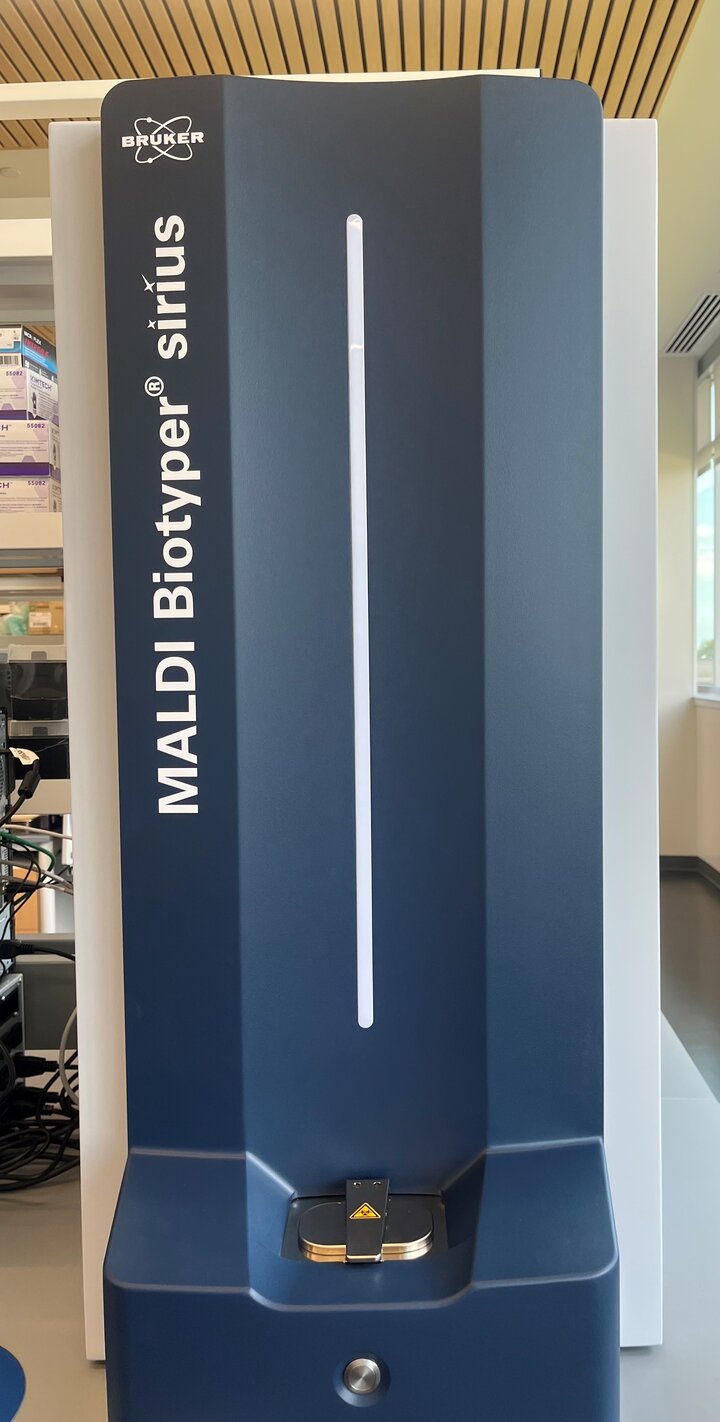
Key equipment
The bacteriology lab:
- Utilizes the MALDI-TOF mass spectrometer for bacterial identification.
- Utilizes the Media Jet, an automated media plate dispenser, when preparing a variety of plated media types to screen for Salmonella species.
Essential pieces of equipment in the bacteriology section include incubators, microscopes, susceptibility test equipment, pipettes, centrifuges and biosafety hoods.
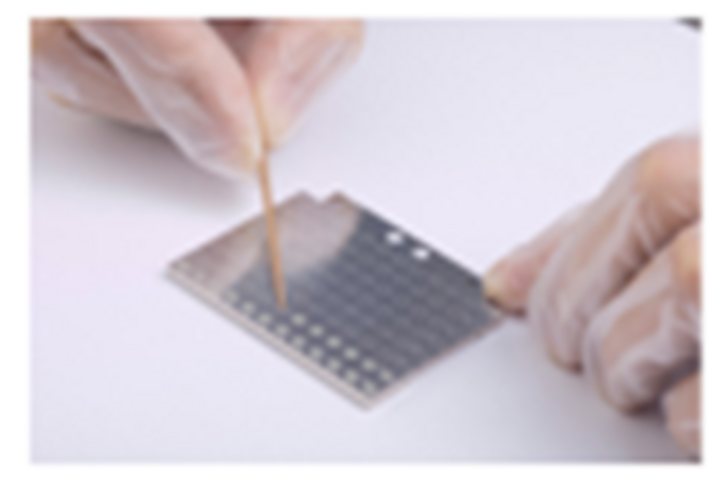
Asian Longhorned Ticks found in Iowa
By Dr. J. Dustin Loy
With recent reports of the Asian Longhorned Tick (ALHT) (Haemaphysalis longicornis) in Iowa and other states, we are providing the following guidance for diagnostic testing.
Tick Identification
Proper removal, storage, and transport of ticks is important for accurate identification.
- Ticks should be removed by grasping them by the mouthparts as close to the skin of the host as possible. Mouthparts are typically important for tick identification.
- Ticks should be placed in sealable containers (e.g., glass vials, plastic vials) with alcohol, preferentially 70-90% ethanol.
- Ticks do not have to be refrigerated or frozen.
- The more ticks submitted, the better, since prevalence is unknown.
- Vials should be shipped using ambient temperature packing with absorbent material, placed in a plastic bag to avoid spillage through the packaging, and placed in a rigid box.
- Samples can be submitted using our ruminant submission form with a test request for Parasite ID.
- Mailing labels can be ordered and printed directly from our Shipping webpage.
- Samples may be required to be forwarded to USDA for confirmatory identification. There is no additional cost for this.
Theileria
The ALHT is a carrier of Theileria orientalis, a protozoal pathogen that causes bovine infectious anemia. There are no approved treatments for these infections, so tick control and biosecurity are essential to disease prevention.
NVDC offers multiplex testing for Theileria orientalis and Anaplasma marginale, two common causes of infectious anemia. PCR testing can be conducted on whole blood samples, with pooling available of up to five samples.
Additional testing information for Theileria can be found here. Theileriosis is a notifiable disease in Nebraska requiring state notification.
Tick-related questions
If you have tick-related questions, contact:
Roberto Cortiñas, DVM, Ph.D.
Associate Professor of Practice
School of Veterinary Medicine and Biomedical Sciences
University of Nebraska–Lincoln
113 VBS, Lincoln, NE 68583-0905
Phone: 402-472-6502
Email: rcortinas@unl.edu
Other questions can be directed to:
J. Dustin Loy, DVM, Ph.D., Dipl. ACVM
Professor and Director
Nebraska Veterinary Diagnostic Center
School of Veterinary Medicine and Biomedical Sciences
Phone: 402-472-1434
Email: jdloy@unl.edu
New World Screwworm
Recent detections of New World Screwworm (NWS) as close as 370 miles to the U.S. southern border have raised concerns about reintroduction of this foreign animal disease that was eradicated decades ago. Recent border closures to animal imports, including cattle, have been implemented to reduce risk of reintroduction.
NWS is a reportable disease. Please contact your state or USDA APHIS veterinarian if you have any suspected cases. Additional information can be found in New World Screwworm What You Need to Know on the USDA APHIS website.
Case report: Enzootic bovine leukosis
By Dr. Matt Hille
An 8-year-old, Black Angus cow was presented to the NVDC for necropsy. She had a history of lethargy, nasal discharge and a swollen brisket that responded to initial treatment. Two weeks later, she became lethargic again and died while being brought to the chute for treatment.
Gross lesions included: 1) moderate ventral edema and icterus throughout the subcutaneous tissues and abdomen, 2) a moderate amount of red tinged, watery fluid within the abdomen (estimated at several liters), 3) a copious (10L+) amount of red/brown, watery fluid within the thorax with a mild amount of red-tinged pericardial fluid, 4) a markedly enlarged heart weighing weight 5.8 kg, with multifocal to coalescing areas of light-green friable material within the myocardium that was otherwise was appreciated as diffusely pale, and 5) a moderately pronounced lobular pattern throughout the liver that also had rounded edges.
Histologic exam of routine tissues obtained during the necropsy displayed neoplastic lymphocytes infiltrating 30-40% of the myocardium with sporadic areas of necrosis and occasional foci of mineralization (see image below). Neoplastic lymphocytes were also observed infiltrating the liver, kidney, abomasum, rumen, lung and spleen to varying degrees. Quantitative PCR for bovine leukemia virus (BLV) on fresh heart muscle was positive (Ct of 28.15), warranting the diagnosis of enzootic bovine leukosis (EBL) caused by BLV.
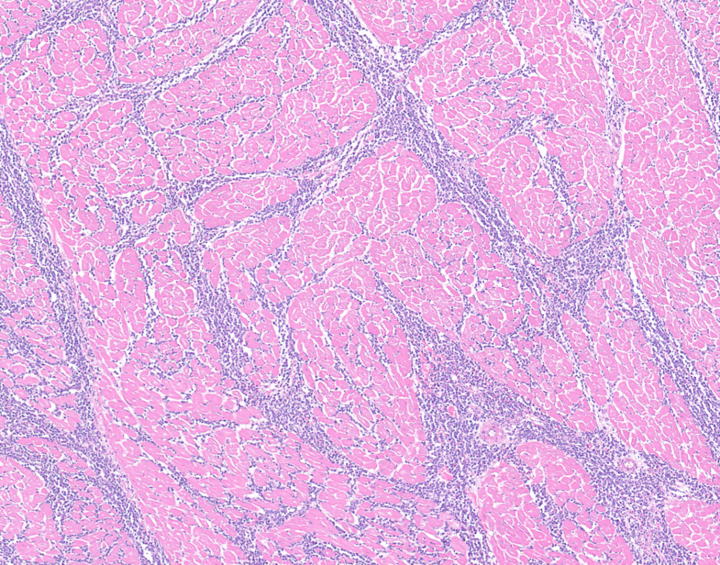
Cattle can present with lymphosarcoma (often referred to simply as lymphoma) in several ways. In adult cattle, BLV infection is responsible for the vast majority of cases. Sporadic (non-BLV associated) forms of lymphosarcoma also happen in cattle, including juvenile, thymic, and cutaneous forms, but these tend to only affect younger cattle (young calves up to 2-3 years of age). While roughly 40% of US beef herds and 10% of individual beef cows are thought to be infected with BLV, the majority of animals never display noticeable clinical signs, and only a fraction of cattle infected will develop lymphosarcoma. Nonetheless, EBL can still have economic impacts for the industry.
Horizontal transmission of the virus is regarded as the primary method of transmission within and between herds. Injections with needles contaminated with the blood from other animals, rectal palpation or ultrasound without changing sleeves in between each animal, and tattooing without disinfecting equipment between animals are risk factors for transmitting the virus. Following the guidelines of cattle husbandry as outlined by the Beef Quality Assurance (BQA) program can help mitigate the risk of BLV introduction or spread. For more information on BQA in Nebraska, visit their website.
There is no effective treatment for EBL in cattle, and strategies to control and/or eliminate the virus in herds varies widely, and introduction of even a single positive animal risk spread to herd mates, so testing of new animals can be an important management strategy.
Testing options for BLV at the NVDC include both ELISA on serum to identify prior exposure and, therefore, presumed infection, as well as PCR on whole blood and/or semen.
Client services
Now offering reduced shipping cost through UPS for biopsy mailers
For many years, we have offered biopsy mailers, including boxes, formalin jars, and free shipping through the United States Postal Service (USPS). Recently, it has become clear that we can no longer anticipate samples reaching the lab in a timely manner with USPS. Due to increasing delays in delivery times (sometimes up to two weeks), we encourage our customers to use UPS through the NVDC EZ-Ship program (instructions on that webpage).
To help support this, NVDC will reduce shipping charges for biopsy mailers to a flat $5 fee, which will be added to the case corresponding to the sample. This pricing is for biopsies only. All other packages can be sent as usual using UPS EZ-Ship at the rates listed on the website.
For those who would like to continue to use USPS or do not have access to UPS, the NVDC will still supply USPS labels, which are located inside the biopsy mailer box. The label will need to be affixed to the box. However, please note there is no guarantee of timely delivery. Sending time-sensitive samples through USPS is strongly discouraged.
To use EZ-Ship, do not use the USPS label provided in the biopsy mailer kits.
- Print label through the NVDC Shipping webpage.
- In the dropdown for submission type, select “biopsy mailer.” In order to be charged the $5, biopsy mailer price (not biopsy) must be selected.
- Choose the green submission form with a yellow-colored sticker for samples shipped via UPS.
- Choose the white submission form with no sticker to ship samples via USPS.
We understand that some of you may want to start sending by UPS but currently have our histology mailers with USPS stickers already affixed. In this case, place the UPS label on the box so that it completely covers the USPS sticker.
While we wish to keep providing shipping support through USPS, we also want to provide excellent customer service, which is compromised by extended shipping times. We appreciate your business, and we sincerely hope that this will help ensure a faster turn-round time for your clients’ testing results.
New Test Pricing Effective July 1
Here at the Nebraska Veterinary Diagnostic Center, we are committed to providing high-quality services while maintaining fair and competitive pricing. Due to rising operational costs, we will be adjusting some of our rates effective July 1, 2025. This change will allow us to continue delivering the excellent service and value you expect from us. We appreciate your understanding.
New test pricing can be viewed here. Rates are subject to change.
Employee recognition
David Steffen selected for BIF Pioneer Award
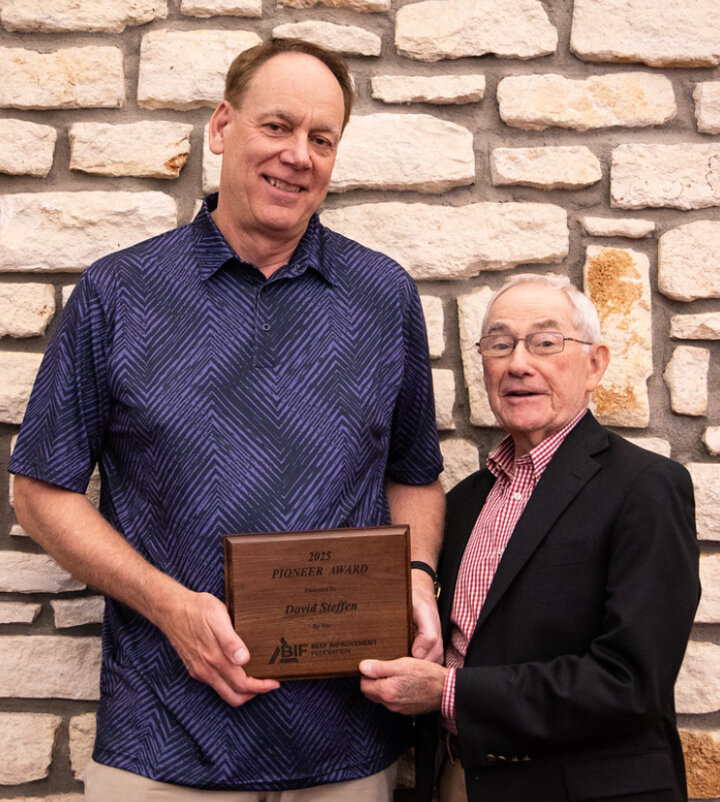
David Steffen, professor, genetics specialist and pathologist at NVDC, received the 2025 Pioneer Award from the Beef Improvement Federation. It was presented at the BIF Symposium held in Amarillo, TX.
The Pioneer Award recognizes individuals who have made lasting contributions to the improvement of beef cattle and honors those who have had a major role in acceptance of performance reporting and documentation as the primary means to make genetic change in beef cattle.
Steffen grew up on his family’s farm near Fordyce, Nebraska, where his passion for livestock and veterinary medicine began. After earning a B.S. in Animal Science from the University of Nebraska-Lincoln and a D.V.M. from Iowa State University, he completed a doctoral degree in pathology at Kansas State University. He spent most of his academic career at the University of Nebraska-Lincoln, where he served as faculty head for quality assurance and accreditation at the NVDC.
Considered a national resource for investigating genetic disorders in beef cattle, Steffen’s research has contributed to the commercial testing of nearly 70 percent of known genetic disorders in beef cattle. His work in discovering genetic conditions and helping producers manage breeding around them has significantly impacted breed improvement. Throughout his career, he has demonstrated a strong passion for advancing cattle health and supporting producers.
Employee spotlight
Dr. Seth Harris is a tenured full processor and a board-certified anatomic pathologist. He attended veterinary school at Colorado State University, after which he completed a combined pathology residency and Ph.D. at Washington State University.
Dr. Harris has served the Diagnostic Laboratory at UNL since 2009. While his position is predominately diagnostic service, he has been engaged in a variety of collaborative research projects and teaches the veterinary students in the Professional Program in Veterinary Medicine.
Dr. Harris' primary areas of diagnostic interest are in dermatopathology, infectious diseases, hepatic pathology and ocular pathology.
Outside of his time in the diagnostic laboratory, Dr. Harris enjoys running half marathons, speaking Swedish, baking bread, sailing, hunting and hiking.

Empoyee pet spotlight
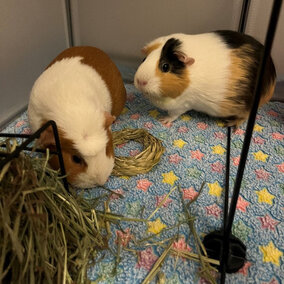
Meet Poppy and Petunia. These two round ladies are two-year-old guinea pigs who were rescued from a local pet shelter. They enjoy eating anything and everything, squeaking at their owners to remind them to feed them, and making a mess of their cage as soon as it has been cleaned.
Poppy and Petunia are owned by Charlotte and Olivia, the daughters of the NVDC bacteriology lab manager Laura Leger.